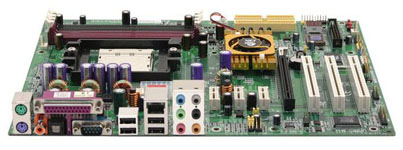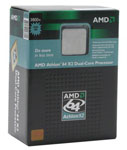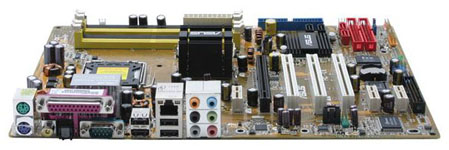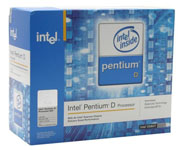Mid-Range Buyer's Guide, September 2005
by Jarred Walton on September 19, 2005 12:05 AM EST- Posted in
- Guides
Office CPU and Motherboard Recommendations
For the non-gaming configurations (which we're loosely terming "office" here), our motherboard and processor picks are very different. While dual core at present does little to nothing for gaming other than to increase costs (or allow you to run applications in the background while gaming), the same is not true of non-gaming applications. Many professional business applications are already optimized to support SMP (Symmetric Multi-Processing - in other words, multiple CPU cores) configurations. Video encoding, image editing, 3D rendering, and software development can all take advantage of the second CPU core. At the same time, even the cheapest of modern graphics cards is more than sufficient for most non-gaming work. There's a reason why Intel currently has more installed graphics chips than anyone else: for business use, integrated graphics are perfectly adequate. Multitasking will also benefit from the addition of a second CPU core, so burning a DVD while surfing the web, running your virus scanner, etc. shound't be a problem.
Here, Intel has the clear advantage, simply in terms of pricing. While the Intel Pentium D chips are not as fast as the AMD X2 chips, we're less concerned with maximum performance than we are with having a second core. DVD burning and web browsing aren't going to max out even a single CPU core, but the context switching that the CPU has to do in order to run both tasks at the same time can have an impact (especially under Windows XP). If you're running two CPU intensive tasks, of course, dual cores will be tremendously helpful. We've labeled this setup as "Office", but it is also useful for non-business tasks, with DVD playback/ripping/encoding, PVR duties, and even moderate gaming topping the list. In short, they're good systems for homes as well as businesses.
AMD Office Motherboard: EPoX EP-9NPA+Ultra
Price: $98 shipped
AMD Office CPU: Athlon 64 X2 3800+ 2x512K 2.0GHz
Price: $361 shipped (Retail)
Total: $459
If gaming isn't a primary concern, the use case for SLI is greatly diminished. Sure, you can use the second slot for a non-graphic device, but most of those will be fine in an X1 or X2 slot instead. Given the current price premium for SLI boards - especially the higher-quality boards - we're going to skip that for our business configuration. The EPoX EP-9NPA+Ultra received top marks in our nForce4 Ultra Roundup, and at under $100, it's a great bargain. Paired with the lowest priced Athlon X2 part, the 3800+, we still end up spending around $150 more for the motherboard and CPU relative to our Gaming configuration, but we'll save that money elsewhere. This is a potent combination and should meet just about any business/home needs for several years. About the only additions that might be required in the next year or two are a new graphics card, more data storage, and/or more RAM. (You'll probably be upgrading the OS at some point as well.)
While we've said that Intel has the pricing advantage, we really need to qualify that statement. Yes, the X3800+ is substantially more expensive than the Pentium D 820 (and even the 830 is cheaper). The quality Intel motherboards do cost a bit more, however, making the Pentium D 830 a roughly equal price. If you look at the single core foundation of the parts rather than the model number, though, you get some interesting details. A single 2.0GHz 512K AMD core is called the 3200+, making it roughly the equal of the Pentium 4 540 3.2GHz. Two of these cores comprise the X2 3800+, while two 3.2GHz Prescott cores make the Pentium D 840. The 840 actually retails for substantially more than the X2 3800+, so comparing the 3800+ and the 820 is hardly fair. While there are a few applications where the Pentium D wins out in raw performance, the X2 3800+ is definitely the faster chip overall, and it runs cooler as well.
Raw performance isn't really that important for most home users, though. If you'll pardon my anecdote for a minute, I frequently use a Pentium III 1.13GHz with 512MB of RAM, and Word and Excel have no trouble keeping up with my typing speed. Web page rendering on such an old system can be quite a bit slower, but the point is that the majority of what an office computer will do is to sit around waiting for user input. We're not going to list alternatives here, as we really don't feel that anything more expensive is worth considering. You could probably stick with the 3000+ chip and be fine, but the second core is nice to have if/when you need it. You can also overclock the 3800+ quite a bit, with 2.4GHz being a relatively easy mark. That would give you a 4600+ equivalent, and very few home systems can come anywhere near that level of performance, dual core or otherwise.
Intel Office Motherboard: ASUS 945P P5LD2
Price: $132 shipped
Intel Office CPU: Pentium D 820 2x1MB 2.8GHz
Price: $248 shipped (Retail)
Total: $380
Our Intel office choices are similar in some ways to the gaming choices. We once again selected an ASUS motherboard, this time using the 945P chipset. You could get any of the Intel 945P or Intel 945G based motherboards and be reasonably safe in terms of stability, but we do like the added features that ASUS provides, and a quality motherboard is arguably the most important component when it comes to system reliability.
For the processor, we went with the cheapest Intel dual core part. As we mentioned above, this is not at all a fair match in terms of performance, as the AMD chip will easily beat the 820 in pretty much every benchmark. However, given the choice between the Pentium 650 and the 820 for office work, we'd take the 820. If you're looking at the $380 price of this configuration and comparing it with the $459 of the X2 setup, that's a decent savings. We won't actually "save" that money, however, but instead we'll use it to upgrade other aspects of the system.
Alternatives are plentiful for the motherboard. If you just want stock performance, the ECS 945P 945P-A and Biostar I945P-A7 come in at under $100. (We'd guess that ECS actually makes the board for Biostar, although we could be wrong.) Both of those have a second physical X16 slot, but it's only an X1 or perhaps X2 data connection. It can't be used for SLI or for Crossfire at present, but driver updates in the future could very well change that. On the processor side, you could upgrade to the 830 for another $65, coming close to the same cost as the X2 configuration. The extra 200MHz really isn't worth the cost in our opinion, and as we said, we have other plans for the money....
For the non-gaming configurations (which we're loosely terming "office" here), our motherboard and processor picks are very different. While dual core at present does little to nothing for gaming other than to increase costs (or allow you to run applications in the background while gaming), the same is not true of non-gaming applications. Many professional business applications are already optimized to support SMP (Symmetric Multi-Processing - in other words, multiple CPU cores) configurations. Video encoding, image editing, 3D rendering, and software development can all take advantage of the second CPU core. At the same time, even the cheapest of modern graphics cards is more than sufficient for most non-gaming work. There's a reason why Intel currently has more installed graphics chips than anyone else: for business use, integrated graphics are perfectly adequate. Multitasking will also benefit from the addition of a second CPU core, so burning a DVD while surfing the web, running your virus scanner, etc. shound't be a problem.
Here, Intel has the clear advantage, simply in terms of pricing. While the Intel Pentium D chips are not as fast as the AMD X2 chips, we're less concerned with maximum performance than we are with having a second core. DVD burning and web browsing aren't going to max out even a single CPU core, but the context switching that the CPU has to do in order to run both tasks at the same time can have an impact (especially under Windows XP). If you're running two CPU intensive tasks, of course, dual cores will be tremendously helpful. We've labeled this setup as "Office", but it is also useful for non-business tasks, with DVD playback/ripping/encoding, PVR duties, and even moderate gaming topping the list. In short, they're good systems for homes as well as businesses.
 |
 |
| Click to enlarge. | |
AMD Office Motherboard: EPoX EP-9NPA+Ultra
Price: $98 shipped
AMD Office CPU: Athlon 64 X2 3800+ 2x512K 2.0GHz
Price: $361 shipped (Retail)
Total: $459
If gaming isn't a primary concern, the use case for SLI is greatly diminished. Sure, you can use the second slot for a non-graphic device, but most of those will be fine in an X1 or X2 slot instead. Given the current price premium for SLI boards - especially the higher-quality boards - we're going to skip that for our business configuration. The EPoX EP-9NPA+Ultra received top marks in our nForce4 Ultra Roundup, and at under $100, it's a great bargain. Paired with the lowest priced Athlon X2 part, the 3800+, we still end up spending around $150 more for the motherboard and CPU relative to our Gaming configuration, but we'll save that money elsewhere. This is a potent combination and should meet just about any business/home needs for several years. About the only additions that might be required in the next year or two are a new graphics card, more data storage, and/or more RAM. (You'll probably be upgrading the OS at some point as well.)
While we've said that Intel has the pricing advantage, we really need to qualify that statement. Yes, the X3800+ is substantially more expensive than the Pentium D 820 (and even the 830 is cheaper). The quality Intel motherboards do cost a bit more, however, making the Pentium D 830 a roughly equal price. If you look at the single core foundation of the parts rather than the model number, though, you get some interesting details. A single 2.0GHz 512K AMD core is called the 3200+, making it roughly the equal of the Pentium 4 540 3.2GHz. Two of these cores comprise the X2 3800+, while two 3.2GHz Prescott cores make the Pentium D 840. The 840 actually retails for substantially more than the X2 3800+, so comparing the 3800+ and the 820 is hardly fair. While there are a few applications where the Pentium D wins out in raw performance, the X2 3800+ is definitely the faster chip overall, and it runs cooler as well.
Raw performance isn't really that important for most home users, though. If you'll pardon my anecdote for a minute, I frequently use a Pentium III 1.13GHz with 512MB of RAM, and Word and Excel have no trouble keeping up with my typing speed. Web page rendering on such an old system can be quite a bit slower, but the point is that the majority of what an office computer will do is to sit around waiting for user input. We're not going to list alternatives here, as we really don't feel that anything more expensive is worth considering. You could probably stick with the 3000+ chip and be fine, but the second core is nice to have if/when you need it. You can also overclock the 3800+ quite a bit, with 2.4GHz being a relatively easy mark. That would give you a 4600+ equivalent, and very few home systems can come anywhere near that level of performance, dual core or otherwise.
 |
 |
| Click to enlarge. | |
Intel Office Motherboard: ASUS 945P P5LD2
Price: $132 shipped
Intel Office CPU: Pentium D 820 2x1MB 2.8GHz
Price: $248 shipped (Retail)
Total: $380
Our Intel office choices are similar in some ways to the gaming choices. We once again selected an ASUS motherboard, this time using the 945P chipset. You could get any of the Intel 945P or Intel 945G based motherboards and be reasonably safe in terms of stability, but we do like the added features that ASUS provides, and a quality motherboard is arguably the most important component when it comes to system reliability.
For the processor, we went with the cheapest Intel dual core part. As we mentioned above, this is not at all a fair match in terms of performance, as the AMD chip will easily beat the 820 in pretty much every benchmark. However, given the choice between the Pentium 650 and the 820 for office work, we'd take the 820. If you're looking at the $380 price of this configuration and comparing it with the $459 of the X2 setup, that's a decent savings. We won't actually "save" that money, however, but instead we'll use it to upgrade other aspects of the system.
Alternatives are plentiful for the motherboard. If you just want stock performance, the ECS 945P 945P-A and Biostar I945P-A7 come in at under $100. (We'd guess that ECS actually makes the board for Biostar, although we could be wrong.) Both of those have a second physical X16 slot, but it's only an X1 or perhaps X2 data connection. It can't be used for SLI or for Crossfire at present, but driver updates in the future could very well change that. On the processor side, you could upgrade to the 830 for another $65, coming close to the same cost as the X2 configuration. The extra 200MHz really isn't worth the cost in our opinion, and as we said, we have other plans for the money....










56 Comments
View All Comments
GMAN003 - Friday, October 7, 2005 - link
First of all, Great guide Jarred! Because of your article I am now an AnandTech member for life! @$$kissing aside, here are some of my questions and suggestions for your article.1) Would you have noticed any significant speed gains by using different memory types such as DDR500 memory as recommend by DFI on their website? Yes, I know, its more expensive, but for the enthusiast on a budget, wouldn't overclocking memory be more up my ally especially for any future processor upgrades?
2) For future guides, you may want to consider a more comparable AMD vs Intel office processor. From reading other articles on the web, isn't the AMD64 3800 X2 processor more comparable to an Intel Celeron D 830 processor? In fact, in some benchmarks I have seen the 3800X2 be faster than the Intel Celeron D 840 processor?
3) I bought almost every part in your gaming system for a friend, except for the case/pwr supply and hard drive. Rolling the dice with an Aspire X-Navigator 500watt just for looks and a Raptor74GB for seek/write times. Any future posts on what you have been able to reach as "stable" OC levels and what your detailed bios settings are would be appreciated. From what I keep seeing around the web, most of my framerates in my games should be in the high 100's FPS. :-D Needless to say, I'm happy with the advice.
Again, thanks Jarred.
JarredWalton - Wednesday, October 26, 2005 - link
Heh - old post that I never saw. Glad you liked the article. For overclocking, there are many options. I wrote a "Venice Overclocking" article that covers many of the questions you asked. I'll be doing an Athlon X2 followup.I tried to make it clear in the article that the X2 was far superior in performance than the Pentium D. Price was a consideration, and if there were a cheaper X2 than the 3800+, I would have happily used it. Personally, I'd say the 3800+ actually outperforms even the Pentium D 840 in most benchmarks, and only heavy multitasking with four or more processes will favor the Pentium D 840EE. Once you look into overclocking, it really becomes no comparison. 2.6 GHz on the X2 3800+ compared to perhaps 3.2 or 3.4 GHz on the 820.
Anubis - Sunday, September 25, 2005 - link
especially of an office computer SLI is totally useless, you could save 100$ on the office comp and about 70 on the gameing one by going with a non SLI NF4 moboJarredWalton - Saturday, October 1, 2005 - link
SLI was *not* recommended for the office configurations. The choice of the X700 Pro as the GPU should be clear evidence of that.Crescent13 - Tuesday, September 20, 2005 - link
There are just a few minior things I would change...Jetway SLI motherboard instead of SLI-DR, it might be a bit better value for a mid-range gaming system.
I personally don't really like XFX, because they don't have that great of service and support, I would get an EVGA 7800GT, of course, that's just my opinion :)
I think I would get a hitachi 160GB SATAII hard drive, instead of western digital, hitachi has 8.5 MS seek time, western digital is 8.9 MS.
I would choose a forton source PSU, instead of SunBeam, for more stability.
I think the logitech x-530's would be a better choice than the labtec areana speakers.
this is all just my opinion, it's still a good guide :)
Googer - Tuesday, September 20, 2005 - link
If you are running a Venice Core Processor why would you run PC3200? Venice is perfectly capable of running DDR500 with out over clocking. AMD Said So.Pythias - Tuesday, September 20, 2005 - link
Because amd cpus benefit more form tight timings than bandwidth? http://forums.anandtech.com/messageview.aspx?catid...">http://forums.anandtech.com/messageview...amp;thre...SimonNZ - Tuesday, September 20, 2005 - link
because low latency ddr500 cost a small fortune, well mine did anyhow and most people buying in the mid range of the market arnt going 2 notice the difference....hell i dont:PPythias - Tuesday, September 20, 2005 - link
From what I gather you arent going to notice ddr500 over ddr400 whay spend more money?cryptonomicon - Tuesday, September 20, 2005 - link
uh.."With the motherboard and CPU that we've selected, though, you should be able to reach much higher speeds than 1.80GHz. 2.40GHz (267MHz CPU bus with the stock 9X CPU multiplier) is about as sure of an overclock as anything that we've seen."
no. no overclock is guaranteed and i am pretty surprised i am seeing an advocation for overclocking in this guide. i overclock myself but a brazen statement like that is just inviting hoardes of people to try the board, and not even know what they are getting into. OCing should come into the picture on most gaming hardware but in this guide its more like the OC is sort of an assumed part of the value. i really hate seeing 'sure' associated with 'overclock'. that's just another 100, 200, 1000 people at dfi-street.com that i have to troubleshoot for because they don't know what they are doing. allright well that's just a rant, nothing personal.